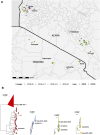Molecular characterisation of human rabies in Tanzania and Kenya: a case series report and phylogenetic investigation
- PMID: 39468631
- PMCID: PMC11514914
- DOI: 10.1186/s40249-024-01245-w
Molecular characterisation of human rabies in Tanzania and Kenya: a case series report and phylogenetic investigation
Abstract
Background: Rabies remains a major public health problem in low- and middle-income countries. However, human rabies deaths are rarely laboratory-confirmed or sequenced, especially in Africa. Five human rabies deaths from Tanzania and Kenya were investigated and the causative rabies viruses sequenced, with the aim of identifying implications for rabies control at individual, healthcare and societal levels.
Case presentation: The epidemiological context and care of these cases was contrasting. Four had a clear history of being bitten by dogs, while one had an unclear biting history. Two individuals sought medical attention within a day of being bitten, whereas three sought care only after developing rabies symptoms. Despite seeking medical care, none of the cases received complete post-exposure prophylaxis: one patient received only tetanus vaccination, one did not complete the post-exposure vaccination regimen, one followed an off-label vaccination schedule, and two did not receive any post-exposure vaccinations before the onset of symptoms. These cases highlight serious gaps in health-seeking behaviour, and in health systems providing appropriate care following risky exposures, including in the accessibility and effectiveness of post-exposure prophylaxis as it is administered in the region.
Conclusions: The viral genomic and epidemiological data confirms dog-mediated rabies as the cause of each of these deaths. The phylogenetic investigation highlights the transboundary circulation of rabies within domestic dog populations, revealing distinct rabies virus clades with evidence of regional spread. These findings underscore the importance of coordinated cross-border control efforts between the two countries. Urgent action is needed to improve awareness around the need for emergency post-exposure vaccines that should be accessible in local communities and administered appropriately, as well as investment in coordinated dog vaccination to control dog-mediated rabies, the underlying cause of these deaths.
Keywords: Lyssavirus; East Africa; Genomic surveillance; Nanopore; Next-generation sequencing; One Health; Whole genome sequencing.
© 2024. The Author(s).
Conflict of interest statement
There are no conflicts of interest.
Figures



References
-
- World Health Organisation. Rabies vaccine: WHO position paper. Wkly Epidemiol Rec. 2018;16:201–20.
Publication types
MeSH terms
Substances
Grants and funding
- 204820/WT_/Wellcome Trust/United Kingdom
- 224670/Z/21/Z/WT_/Wellcome Trust/United Kingdom
- 207569/Z/17/Z/WT_/Wellcome Trust/United Kingdom
- 176382/National Institute for Health and Care Research, Global Health Research Group on the Application of Genomics and Modelling to the Control of Virus Pathogens (GeMVi) in East Africa at the University of Warwickellowship
- WT_/Wellcome Trust/United Kingdom
LinkOut - more resources
Full Text Sources
Medical

